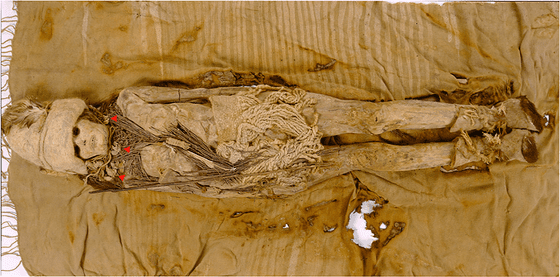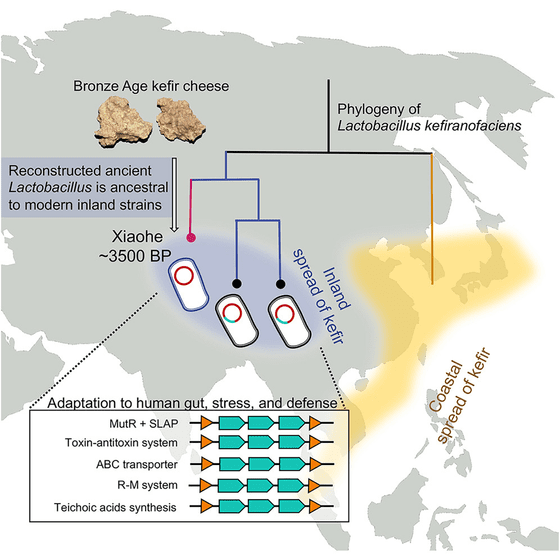Mysterious white substance found on 3,600-year-old mummy turns out to be the world's oldest kefir

A study has revealed that a substance recovered from a Chinese mummy is the oldest known 'kefir cheese' in archaeological history, casting doubt on the conventional wisdom that kefir originated exclusively in the North Caucasus region of modern-day Russia.
Bronze Age cheese reveals human-Lactobacillus interactions over evolutionary history: Cell
Bronze Age Chinese cheese found next to mummies is the world's most ancient at 3,600 years old - Scimex
https://www.scimex.org/newsfeed/bronze-age-chinese-cheese-found-next-to-mummies-is-worlds-most-ancient-at-3-600-years-old
This enigmatic mummy from western China was swathed in cheese | Science | AAAS
https://www.science.org/content/article/enigmatic-mummy-western-china-was-swathed-cheese
The discovery of the oldest known cheese in human history was made by a mummy found in the Xiaohe Cemetery in the Xinjiang Uyghur Autonomous Region of China. The mummy, believed to be from the Bronze Age, about 3,300 to 3,600 years ago, had a whitish substance that appeared to be a dairy product smeared on its face, and three lumps of the same substance were found around its neck.

'This is the oldest cheese sample ever discovered in the world,' said Qiaomei Fu, a professor at the Chinese Academy of Sciences and corresponding author of the paper. 'It is a rare and valuable opportunity, as it is extremely difficult to preserve foods like cheese for thousands of years. By studying ancient cheese in detail, we can gain a deeper understanding of the eating habits and food culture of our ancestors.'

When the team analyzed the mitochondrial DNA of the three samples, they found that they contained both cow and goat DNA. Interestingly, the people who lived in the area at the time were using different animals' milk to make different cheeses, a process that differs from cheese making in the Middle East and Greece, where blending of milk is common.
The lactose content of raw milk is significantly reduced during the cheese-making process, so the research team pointed out that 'producing kefir cheese may not only have had the effect of extending the shelf life of raw milk, but also of alleviating gastrointestinal disorders caused by lactose for the Xiaohe people, who were genetically lactose intolerant.'
More importantly, the team was able to recover microbial DNA from the samples, and the results showed that ancient kefir cheese contained Lactobacillus kefiranofaciens and Pichia Kudriavzevii, both of which are commonly found in modern kefir grains.
Lactobacillus bacteria are roughly divided into two groups based on their origin: one is the 'Russian origin strain' that is used in dairy product manufacturing in Europe, the US, Japan and other countries around the world, and the other is the 'Tibetan origin strain.'
Because the Lactobacillus kefiranofaciens strains found in the three samples were closely related to the Tibetan group, the researchers questioned the long-held belief that kefir originated exclusively from the North Caucasus region.

'Based on our observations, it appears that the kefir culture has been present in the Xinjiang region of northwest China since the Bronze Age,' Fu said.
The kefir grains found around the mummy's neck act as a 'seed' used to ferment raw milk into kefir cheese, similar to a sourdough starter used to initiate the fermentation of bread dough.
It is unclear why kefir grains were included with mummies, but it is thought that they may have been a gift to enable the making of kefir cheese in the afterlife.
'This is an unprecedented study, and it shows how microbes have evolved over the past 3,000 years,' Fu said. 'Furthermore, by investigating dairy products, we have been able to get a clearer picture of ancient human life and its interactions with the world. This is just the beginning, and we hope to use this method to investigate other previously unknown artifacts.'
◆ Forum is currently open
A forum related to this article has been set up on the official GIGAZINE Discord server . Anyone can post freely, so please feel free to comment! If you do not have a Discord account, please refer to the account creation procedure article to create an account!
• Discord | 'Have you ever tried kefir?' | GIGAZINE
https://discord.com/channels/1037961069903216680/1290237369965875310
Related Posts:







